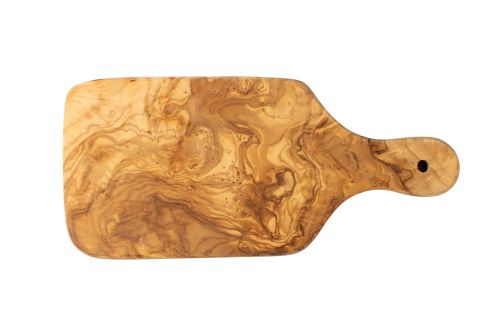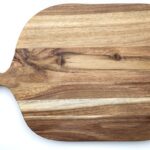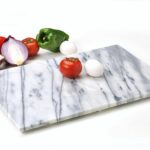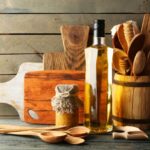Olive wood is made from olive trees that produce olive fruits and grow naturally in the Mediterranean region. The olive tree is very long-lived, but one day it stops bearing fruit. Then the tree can be used to make unique and beautiful kitchen tools. The grain of olive wood is irregular and unique, and no two pieces are alike. Due to its hardness and antibacterial properties, olive wood is popular in the production of kitchen utensils. Since the wood is used from old olive trees that no longer produce fruit, olive wood can be considered a sustainable material for making kitchen utensils, cutting boards, and serving trays.
What Makes Olive Wood Good Material for Cutting Boards?
In this blog post, we’ll take a closer look at the properties that make olive wood a good material for cutting boards but also pay attention to the properties that aren’t ideal for this purpose.
- Unique, attractive look: As olive wood grows slowly, it becomes denser, creating its rich grain pattern with many swirls or twists. Cutting boards and serving trays are usually made from a single piece of wood. Natural color variations and irregular grains make each board unique. The colors range from light caramel tones to dark brown. The smooth texture provides a stunning look. If you are looking for a nice housewarming gift, this board can be the most memorable gift for a new home.
- Durability: Olive wood is hard, durable, and non-porous. Olive wood kitchen utensils are very wear-resistant and durable. They show no signs of damage, so you don’t need to change them often. Olive wood is resistant to stains and odors, so olive wood cutting boards always look clean and new and maintenance is not complicated.
- Antibacterial properties: Due to its natural antibacterial properties, olive wood is considered hygienic and suitable for food preparation. Low porosity and the presence of phenolic compounds help eliminate bacteria and fungi and ensure a hygienic cooking environment.
- Sustainable production: Olive wood is only cut when it no longer bears fruit, which is usually after around 30 years. New trees are planted to produce olive fruit so that the removal of old trees does not contribute to deforestation. This is an example of ethically sourced materials to maintain natural resources.

Is Olive Wood Good for Knives?
Woods with a hardness between 900 and 1500 are best suited for knives. Olive wood has a hardness of around 3000. At 3000, Yanka is too hard for knives. If you regularly cut on an olive wood cutting board, your knife will dull more quickly than with softer wood. However, olive cutting boards are suitable for cutting soft vegetables and fruits. They are also widely used as cheese boards or serving boards.
Olive Wood Cutting Board Care
Never wash your wooden cutting board in the dishwasher. Hand wash your olive wood cutting board with warm water and a mild detergent after each use. Do not leave the board submerged in water and detergent. Rinse it with water and dry it immediately with a soft cloth. Coat the board with food-grade mineral oil or beeswax once a month to nourish and prevent cracking. When not in use, leave the board in a dry and cool place.
Is Olive Wood Food Safe?
Yes, olive wood is safe to use for food preparation. Olive wood cutting boards are more hygienic than boards made from other types of wood. Due to its low porosity, olive wood does not absorb liquids and does not harbor microbes. Antibacterial properties make olive wood the ideal surface for food preparation.
Always purchase olive wood cutting boards from reputable manufacturers to ensure that the wood is properly processed and sealed reducing the possibility of contamination.
Olive trees, like many other plants, can cause allergic reactions.
Olive Wood Charcuterie Boards
Olive wood boards are suitable for charcuterie boards due to their attractive appearance, low porosity, and resistance to microbial growth. Olive wood charcuterie boards can be used to serve a variety of foods for parties and special occasions. When you serve cheese, desserts, appetizers, and flatbreads on them, these beautiful boards create a warm atmosphere and add a touch of natural beauty to your table setting.

Takeaway
I do not recommend using olive wood cutting boards to cut food regularly. Olive wood is an exceptional type of wood and can dull kitchen knives quicker than softer wood. If you prefer wooden cutting boards, consider maple or black walnut as your main cutting board and an olive wood board for serving and display. With their eye-catching glossy surface, olive wood boards add style and rustic appeal to your dining table. As long as you condition the board properly, it will maintain its brand-new appearance and show no signs of damage.



